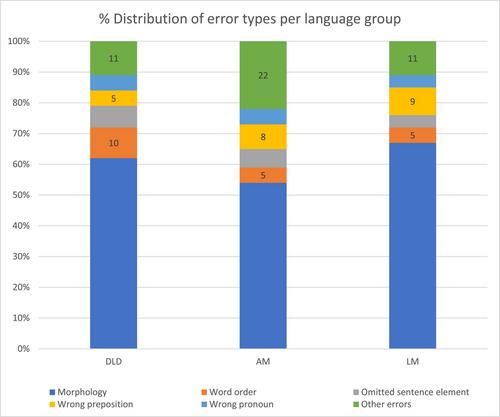Microstructure competences and grammatical errors of Danish-speaking children with developmental language disorder when telling and retelling narratives and engaging in spontaneous language
Abstract
Background
Research on the grammatical characteristics of children with developmental language disorder (DLD) across languages has challenged accounts about the nature of DLD. Studies of the characteristics of DLD in different languages can reveal which components of DLD emerge irrespective of language and which components are language specific.
Aims
To examine the grammatical characteristics of children with DLD acquiring Danish (microstructure and error types) in order to contribute to research on language-general and language-specific characteristics of DLD.
Methods & Procedures
Language samples from two telling narratives, one retelling narrative and one session of semi-spontaneous talk were collected from 39 Danish-speaking children aged 5;0–8;6, comprising one group of children with DLD (n = 15) and two control groups (age- and language-matched: n = 15 and = 9, respectively). The data were analysed with reference to microstructure and grammatical errors. The DLD children's performance was compared with that of their peers with typical language development (AM) and to that of a younger group matched on language comprehension (LM). Task effects were also analysed.
Outcomes & Results
A significant group difference in microstructure was present in the results for mean length of utterance (MLU), where the AM group had significant higher MLU compared with the DLD group. Two variables clearly distinguished DLD children from both AM and LM children in terms of errors, namely word order errors and omission errors. The analysis of grammatical errors also revealed that the most salient challenges for Danish-speaking children with DLD were not clearly morphological in nature. Although the children with DLD, as expected, made more morphological errors compared with the AM group, they did not produce more errors compared with the LM group. Task effects were present for some but not all results.
Conclusions & Implications
This research emphasizes the importance of cross-linguistic comparisons of the linguistic error profiles in the elicited language of children with DLD and the importance of considering the methodological context when analysing the grammatical language abilities of children with DLD. The results are relevant for clinicians and for developing screening tools.
WHAT THIS PAPER ADDS
What is already known on this subject
- DLD is characterized by challenges in producing and comprehending language. Ample research is available on English-speaking children with DLD, and which has reported on challenges acquiring morphology. Studies of children with DLD acquiring other languages than English show challenges related to specific grammatical features of the respective language.
What this study adds to the existing knowledge
- This study is the first to investigate microstructure abilities and grammatical errors produced by Danish-speaking children with DLD and using different language samples (narrative telling, narrative retelling and spontaneous language). It enhances our knowledge about DLD in Scandinavian languages and cross-linguistically and reinforces cross-linguistic findings that grammatical and structural challenges in language acquisition for children with DLD might not be reducible exclusively to morphology. While some components of DLD children's language challenges may appear universal and be attributed to overarching factors other components seem more specific to the structure of the target language. Results from this study additionally draw attention to the importance of considering contextual constraints when investigating productive grammatical abilities in children with DLD.
What are the practical and clinical implications of this work?
- More detailed analysis of grammatical error types seen in children with DLD acquiring languages other than English and of individual differences contribute to clinical advancement in the field. A better insight into grammatical difficulties of Danish-speaking children with DLD may contribute to improved assessment procedures and planning of therapy for children with DLD.


 求助内容:
求助内容: 应助结果提醒方式:
应助结果提醒方式:


